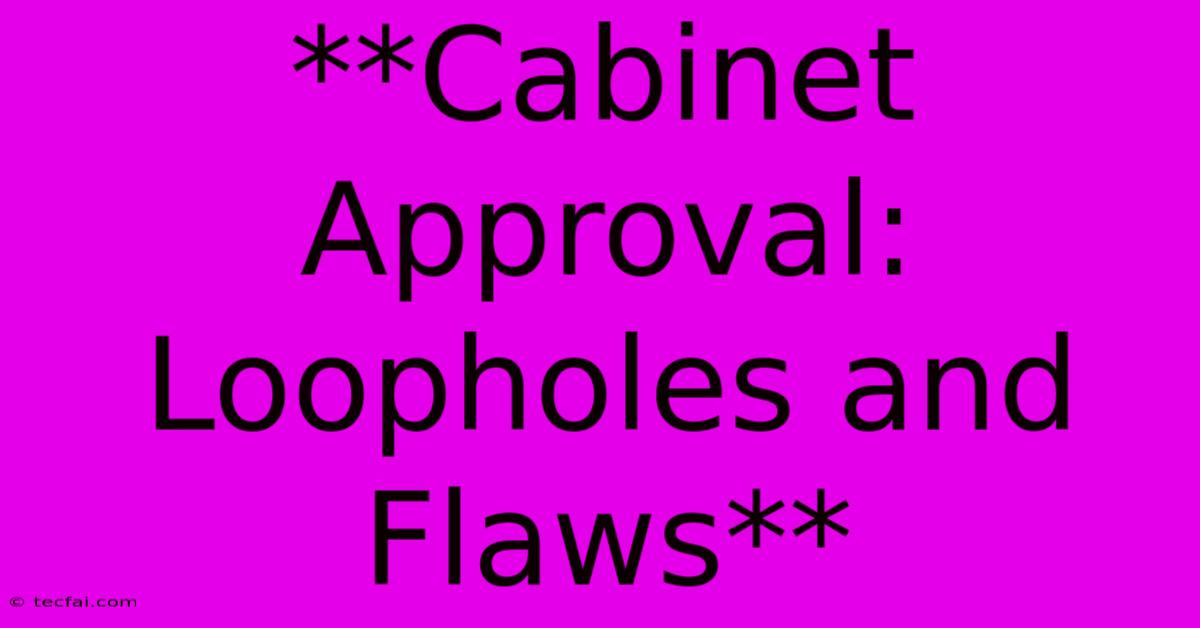**Cabinet Approval: Loopholes And Flaws**

Discover more detailed and exciting information on our website. Click the link below to start your adventure: Visit Best Website tecfai.com. Don't miss out!
Table of Contents
Cabinet Approval: Loopholes and Flaws
Cabinet approvals, while intended to ensure transparency and accountability in government decision-making, often suffer from inherent loopholes and flaws. These weaknesses can lead to ineffective policy, corruption, and a lack of public trust. This article delves into the common problems associated with cabinet approval processes worldwide, exploring their implications and suggesting potential solutions.
Understanding the Cabinet Approval Process
Before dissecting the flaws, it's crucial to understand what constitutes a typical cabinet approval process. Generally, it involves a structured system where proposed policies, projects, or expenditures are presented to a cabinet of ministers for review and approval. This process ideally includes:
- Proposal Submission: Detailed proposals outlining the rationale, objectives, and financial implications are submitted to relevant departments.
- Inter-Ministerial Consultation: The proposal undergoes review and consultation among various ministries to ensure alignment with broader government objectives.
- Cabinet Meeting: The proposal is presented to the full cabinet for discussion, debate, and ultimately, approval or rejection.
- Implementation and Monitoring: Once approved, the proposal is implemented, and its progress is monitored to ensure it achieves its intended goals.
Common Loopholes and Flaws in Cabinet Approvals
Despite the structured nature of the process, several vulnerabilities consistently undermine its effectiveness:
1. Lack of Transparency and Public Accountability
Many cabinet approval processes lack transparency, operating behind closed doors with limited public access to information. This opacity creates fertile ground for:
- Corruption: Deals struck in secret, lacking proper scrutiny, can easily lead to corrupt practices.
- Ineffective Policy: Without public input, policies may not accurately reflect the needs and aspirations of the citizens they are intended to serve.
- Reduced Public Trust: A lack of transparency erodes public faith in government institutions and their decision-making processes.
2. Domination by Powerful Ministers or Bureaucrats
The influence of powerful ministers or bureaucrats can significantly skew the cabinet approval process. This can result in:
- Bias: Proposals favored by influential figures may be fast-tracked, while others deserving of attention are overlooked.
- Ignoring Expert Advice: Expert opinions might be disregarded in favor of the preferences of powerful individuals.
- Prioritization of Personal Gain: Decisions might be made to benefit specific individuals or groups rather than the greater good.
3. Inadequate Scrutiny and Due Diligence
Insufficient scrutiny and due diligence are significant flaws in many cabinet approval systems. This can manifest as:
- Insufficient Research: Proposals might be approved without thorough research into their feasibility, impact, and potential risks.
- Lack of Cost-Benefit Analysis: The financial implications of projects may not be adequately assessed, leading to wasteful spending.
- Overlooking Potential Negative Consequences: Unforeseen consequences or negative externalities may not be fully considered before approval.
4. Inefficient Processes and Delays
Bureaucratic inefficiencies and lengthy delays can hinder the effectiveness of cabinet approvals. This can lead to:
- Lost Opportunities: Timely implementation of important policies may be delayed, resulting in missed opportunities for economic growth or social progress.
- Increased Costs: Delays can inflate the overall cost of projects, reducing their value for money.
- Frustration and Disengagement: Prolonged delays can demoralize officials and the public, leading to frustration and disengagement.
Improving Cabinet Approval Processes
Addressing these flaws requires a multifaceted approach:
- Strengthening Transparency Mechanisms: Implementing measures such as public consultations, publishing meeting minutes (with appropriate redactions), and proactively disclosing information about cabinet decisions.
- Promoting Independent Oversight: Establishing independent bodies to review cabinet decisions and ensure compliance with regulations and ethical standards.
- Improving Inter-Ministerial Coordination: Streamlining communication and collaboration among ministries to ensure a more cohesive and effective decision-making process.
- Investing in Capacity Building: Training civil servants in project management, cost-benefit analysis, and risk assessment.
- Empowering Civil Society: Encouraging participation from civil society organizations and other stakeholders in the policy-making process.
By proactively addressing these loopholes and flaws, governments can significantly enhance the effectiveness, transparency, and accountability of their cabinet approval processes, ultimately fostering greater public trust and more effective governance. The implementation of these changes requires political will and a commitment to good governance, but the potential rewards in terms of improved policy and increased public trust are considerable.

Thank you for visiting our website wich cover about **Cabinet Approval: Loopholes And Flaws**. We hope the information provided has been useful to you. Feel free to contact us if you have any questions or need further assistance. See you next time and dont miss to bookmark.
Featured Posts
-
Ct Social Security Bill Clears House Raises Benefits
Nov 15, 2024
-
Columbus November Full Moon Weather Forecast
Nov 15, 2024
-
Greece Vs Opponent Uefa Nations League Live Stream
Nov 15, 2024
-
1st T20 I Australia Defeats Pakistan By 20 Runs
Nov 15, 2024
-
England Crushes Canada 9 2 In Cp Match
Nov 15, 2024
